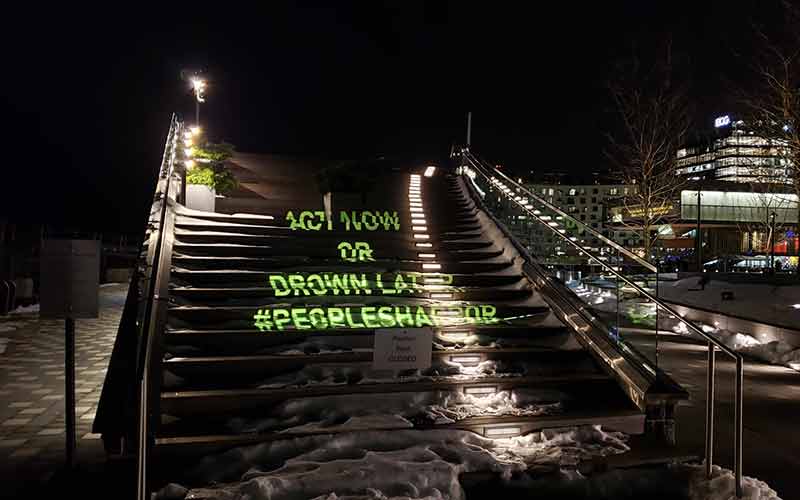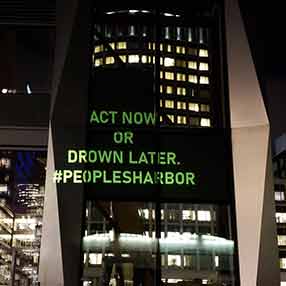
Projected on the steps of the Lookout Pavilion at Fan Pier, our message served as a stark reminder that unless our leaders take action to make our neighborhoods climate resilient now, Boston's waterfront may disappear later.
In recent years, we’ve started a new December tradition at Conservation Law: Heading out to the Seaport district to remind the people who live and work there about the unique challenges the neighborhood faces due to its waterfront location.
It may seem counterintuitive to do this in December, but cold weather doesn’t stop the threats to the public’s access to Boston’s waterfront. And the risks from climate change don’t stop, either, just because the temperature has plummeted.
This year, our annual reminder took the form of a message projected onto prominent outdoor spots in the neighborhood. We called for action to make the Seaport – and all of Boston – resilient in the face of the climate impacts, like sea level rise, that we know are coming. But we were soon reminded that climate resiliency and public access go hand in hand.
Act Now or Drown Later
The urgency to act to protect Boston’s waterfront – and indeed, the entire city – from the dangers of flooding and storms has become ever more apparent. A few years ago, the Seaport flooded twice during winter Nor’easters that caused millions of dollars in damage. And just a few weeks ago, we captured video of a King Tide lapping Boston’s shores. It looks nice now, but it portends serious dangers to come.
Earlier this year, we issued a report – Climate Change and the Massachusetts Public Waterfront Act – that examined which of Boston’s neighborhoods are most at risk. It won’t surprise anyone to know that the Seaport ranked high on the list of vulnerable areas. The report also showed that many other Boston neighborhoods, including East Boston and Dorchester, face significant flood risks due to climate change. These risks will only grow more severe if we don’t take serious steps to address them.
It is clear that we need to be taking action now to make buildings and public spaces more resilient. However, we have seen little movement at the city, state, and federal levels to do so.
That’s why our projected message in the Seaport last week urged our leaders to “Act Now or Drown Later.” We must act today, or Boston’s waterfront will disappear and people’s lives endangered.
Threatening Public Access

Even as we focused on this critical message, however, we were given a real-time lesson in how those with status and power ignore it – and in fact, will do what they can to stop such statements from being spread.
We chose as one of our locations the Lookout Pavilion, a staircase at Fan Pier that serves as a public viewing area in the warmer months. With winter approaching, the pavilion roof is now closed. But the structure is on the Harborwalk, which is open to the public 24/7 as required by state law.
As we stood on the Harborwalk and aimed our projector towards the staircase, we were confronted by a Fan Pier security officer. He told us we were not allowed to do what we were doing.
To be clear, we were not holding an official protest. We were not defacing property or altering it. At most, someone could have complained about the noise our generator was making. But the security officer made it clear that his objection was not to the generator noise but to the fact that we were projecting a message.
We asserted that the area is supposed to be open and accessible to the public, but the security guard wouldn’t budge, saying again that we could not do what we were doing with our projector. After we refused to leave, he told us he was going to call the police.
We left shortly after that because we had already been there for several minutes and had taken photos of the projected message. We wanted to move on to our next location. But it was a sobering reminder of the intimidation tactics some will use to prevent people from using publicly accessible open space. Unfortunately, this is often the case when public spaces are privately owned – as is true for much of the Seaport.
What’s Next?
Time for creating a resilient waterfront is quickly running out. By next December, we wish to project a more hopeful message – one that acknowledges how the city, state, and private developers have taken meaningful steps to create, not just plan for, a more resilient Boston. We also hope that education and advocacy around public access rights prevent future encounters like the one we experienced with the Fan Pier security guard.
We’re continuing both of our efforts to promote public access and highlight the threat of climate change. Will you join us? Visit our People’s Harbor page and sign our pledge. Together, we can take back our People’s Harbor and create a healthy, thriving waterfront – for all.



